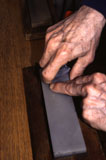| For
the purposes of this lesson we will use a chisel. The exact same motions
apply when sharpening anything. Thinner tools, such as plane blades,
are harder to hold firmly without rocking; this is because the bevel
has less area upon which to seat solidly on the stone. However, once
you have mastered the technique of holding a chisel firmly, without
rocking, holding a plane blade correctly will occur with only a little
more practice. |
The
key to maintaining a consistant bevel is to hold the tool so that
the bevel is in contact and remains in contact with the stone.
Note:
In the following examples using oilstones the stones have all
been doused with a liberal amount of oil.
|
 |
It
is possible to hold the bevel flat against the honing stone with a
single finger. While this is tiring and impractical, it does serve
as the basis for a grip on the blade that will concentrate force at
the bevel. |
 |
Using
one or two fingers of the left hand (more fingers for wider blades),
press down on the back of the blade at the very tip. The bevel must
touch the stone firmly (oil will squish out). With the right hand
add gentle support but allow the left hand's downward pressure to
dominate totally.
|
 |
Here
you see the middle finger of the left hand pressing down at the front
of the blade and the thumb and forefinger of the right hand grasping
the sides of the blade as close to the stone as possible. |
 |
From
the back you can see how the fingers of the right hand curl lightly
under the blade to take some of the weight of the blade. |
|
Left
and Right Hand Pressure
|
|
Preventing
the blade from rocking during the back-and-forth of honing is perhaps
the single most important part of the sharpening process. What we
did with our hands (above) can best be summarized as follows:
- Left
hand, powerfully downward at the tip.
- Right
hand, loose and low around the blade.
|
|
A
little extra detail about this may be helpful.
|
| The
left
hand
pressure should come from straight, rigid fingers, never bent backwards
(inefficient and painful). These fingers can even be curved down (not
illustrated) like claws, with as many fingers, side by side, as the
blade width allows. The fingers should be all the way forward, nearer
the tip than the heel of the bevel. Don't worry about the fingers
riding very close to the cutting edge: They are on top, not in the
path of the edge motion. Press down hard until it almost hurts. |
| The
right
hand
hold of "loose and low " is of critical importance. To start, gently
straddle the blade from left to right (not from top to bottom), thumb
on the left edge, index finger at the right edge. Curl the remaining
three fingers lightly under the blade (as in the pictures). The right
hand should be low enough to touch the left hand. |
|
The
reason for the right hand's being loose and low:
1:
The clear downward "click" of bevel to stone gets blurred by a rigid
right hand grip. You can't hear and your can't feel the click of
contact, though too much right hand tension. Experiment with a loose
then a tight right handgrip. Notice the loss of a clear clicking.
Sensations as a tightened right hand mutes the impact, so it feels
blurry, as through the bevel were round. A question to ask: Is the
right hand purely passive, or does it help out? Well, it helps but
subtly. It relieves the some of the left hand's strain by supplying
just enough weak upward pressure to help glom the bevel home. In
this dance the left hand leads, the right follows.
2:
The reason for keeping the right hand cradled low on the blade is
that the right hand, held high up, gains undesirable, superior leverage.
Any slight twitch of the right hand easily overwhelms the left's
solid contact; The bevel's heel is only a tiny fulcrum, which is
acted on by increasing the lever's length (when then right hand
is raised high.
|
|
|
